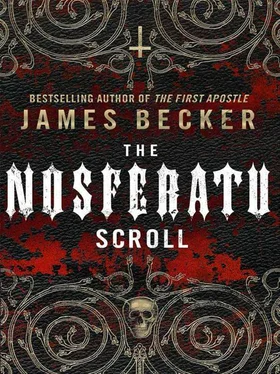James Becker - The Nosferatu Scroll
Здесь есть возможность читать онлайн «James Becker - The Nosferatu Scroll» весь текст электронной книги совершенно бесплатно (целиком полную версию без сокращений). В некоторых случаях можно слушать аудио, скачать через торрент в формате fb2 и присутствует краткое содержание. Жанр: Триллер, на английском языке. Описание произведения, (предисловие) а так же отзывы посетителей доступны на портале библиотеки ЛибКат.
- Название:The Nosferatu Scroll
- Автор:
- Жанр:
- Год:неизвестен
- ISBN:нет данных
- Рейтинг книги:4 / 5. Голосов: 1
-
Избранное:Добавить в избранное
- Отзывы:
-
Ваша оценка:
- 80
- 1
- 2
- 3
- 4
- 5
The Nosferatu Scroll: краткое содержание, описание и аннотация
Предлагаем к чтению аннотацию, описание, краткое содержание или предисловие (зависит от того, что написал сам автор книги «The Nosferatu Scroll»). Если вы не нашли необходимую информацию о книге — напишите в комментариях, мы постараемся отыскать её.
The Nosferatu Scroll — читать онлайн бесплатно полную книгу (весь текст) целиком
Ниже представлен текст книги, разбитый по страницам. Система сохранения места последней прочитанной страницы, позволяет с удобством читать онлайн бесплатно книгу «The Nosferatu Scroll», без необходимости каждый раз заново искать на чём Вы остановились. Поставьте закладку, и сможете в любой момент перейти на страницу, на которой закончили чтение.
Интервал:
Закладка:
James Becker
The Nosferatu Scroll
Prologue
10 May 1741
Krumlov Zamek, Cesky Krumlov, Bohemia
‘Open it.’
The torchlight gave the priest’s face a haunting, almost satanic, quality, an impression reinforced by the chamber in which he was standing. It was a small underground room in the castle, located in the same part of the building as the cages that held the wolves. Four flickering torches were mounted in sconces, one on each wall, but they failed to drive away all the shadows.
A sturdy table stood in the centre of the room, and on it lay a large, ornate, black wooden coffin, the closed lid divided into two parts and hinged on one side, the other edges secured with screws. The coffin had arrived from the Schwarzenberg Palace in Vienna two days earlier and had immediately been carried into St George’s Chapel in the castle. There, the upper section of the coffin had been opened to allow the mere handful of mourners who had appeared in the building to see the thin, white face of the body inside.
The princess had come home for the last time.
Masses for the immortal soul of Princess Eleonora Elisabeth Amalia Magdalena von Schwarzenberg had been held all over Bohemia, but few people made the journey to the vast castle — which wasn’t a single structure at all, but a complex of huge yellow and grey stone buildings roofed with red tiles — that stood on the north bank of the Vltava River.
It was here that her burial was about to take place, and there were preparations — important preparations — to be made.
Four servants had carried the coffin down from St George’s Chapel. Now, one of them moved forward in response to the priest’s instruction and removed the handmade iron screws that secured the upper part of the lid. His task done, he stepped back.
‘No. Take all of them out,’ the priest ordered.
The man looked surprised, but obediently removed the remaining fastenings that held down the lower section of the lid. As he worked, he glanced back at the priest, wondering why the man who’d so publicly shunned the princess while she was alive was now so concerned with her dead body.
The priest’s name was Bohdan Reznik, the surname meaning ‘butcher’, and in truth he looked as though he would be more at home in a bloodstained apron than in the plain, dark brown robes he habitually wore.
When the body of the Princess Eleonora Amalia had been delivered to the castle, one of the escort party had walked down into Krumlov town, found Reznik at his home and handed him a single folded sheet of parchment. The document bore three separate seals, one of them the distinctive double-headed eagle mark of Karel VI, King of Bohemia, the current ruler, and a member of the Habsburg dynasty, which had governed the country since 1526.
The instructions contained on the parchment were unambiguous, and made perfect sense to Reznik. He’d noted with satisfaction that his orders had been prepared by Dr Franz von Gerschstov, Eleonora Amalia’s preferred physician, and a man whose other, less well-known, qualities struck a chord with Reznik.
The servant removed the final screw, and stepped back from the coffin once more, awaiting any further instructions the priest might issue.
‘Swing back the lid,’ the priest said, and watched as two of the servants did so, to reveal the whole interior of the coffin.
‘Now leave me with her. You may return in half an hour.’
Only when the door of the small room had closed behind the men did the priest step forward. He walked across the flag-stoned floor to the coffin and looked down with distaste at the slight figure of Eleonora Amalia. Her hands were placed demurely on her breast, the right hand resting on the left, her wasted body clad in a long white dress, her small feet bare.
Reznik felt in the pocket of his habit and pulled out a folding knife with a black wooden handle. He’d spent several minutes the previous evening putting a fine edge on the dark steel blade.
He made the sign of the cross and muttered a prayer — not for the immortal soul of Eleonora, but for himself, asking for forgiveness and divine protection for the actions he now had to take. He lifted the princess’s hands and lay her arms at her sides, then snapped open the knife. Reznik inserted the blade under the neckline of the dress and in a single fluid movement ran the knife all the way down to Eleonora’s feet, slicing through the layers of material. Then he peeled aside the two cut halves of the dress and looked down at her naked body. The skin that had been so white in life was now mottled and discoloured, with livid brown and purple marks where the initial stages of decay had taken hold.
But that wasn’t the most noticeable feature. What held Reznik’s attention was the crudely stitched cut that ran from between the princess’s small, wrinkled breasts down to her pubis.
Her nakedness offended him, but he had his instructions. His expression of distaste deepened as he again used his blade, this time to slice through each of the rough stitches that held the skin and flesh of her abdomen closed. Then he put down the knife, inserted his fingers into the wide incision and with little difficulty pulled apart the two sections of dead tissue. He was looking for one thing, one single object in the chest cavity, and in seconds he knew it wasn’t there — which was as it should be. But Reznik had been ordered to make absolutely sure before the burial took place.
He nodded in satisfaction, wiped his hands on the front of his robe and stepped back from the open coffin. Then he walked across to one corner of the chamber, where another, much smaller and very plain wooden box was propped against the wall. Reznik was a strong man, and he picked up the box with little effort. He carried it across to the table, placed it next to the princess’s coffin, and lifted off the lid.
Then he strode back to the wall of the chamber and picked up a leather bag, the contents of which clattered metallically as he carried it over to the table. He placed the bag on the floor, opened it and took out three substantial leather straps, which he positioned under the open box, spacing them equally along its length.
He reached into the larger casket, picked up the mortal remains of Eleonora Amalia and dropped the body unceremoniously into the smaller box. Before he placed the lid in position, he took a small vial of clear liquid from his pocket and sprinkled the contents over the corpse, muttering a prayer as he did so. Then he took a hammer and a handful of nails from his bag, and drove a dozen of them firmly through the box’s lid, securely sealing it to the base. To complete the process, he knelt down and tightened each of the leather straps around it.
Reznik took a deep breath and then, grunting with the effort, he lifted up the small wooden box and manoeuvred it into the larger coffin. It would have been easier to wait until the servants returned, but his instructions had been clear — when they returned to the chamber, he was to have sealed the coffin for the last time. Nobody must ever know what he had done. He closed the lid and started replacing the screws.
When the servants knocked at the door a few minutes later, Reznik had finished securing the lid and was standing beside the coffin, waiting for them.
‘We leave the castle at eight,’ he said. ‘Ensure that the carriage is ready and everything has been prepared by then.’
A few minutes before the appointed hour, Reznik strode into the castle courtyard. Night was already falling, and the expansive open space was in deep shadow, the only illumination coming from the fitful flames of the torches mounted along the walls.
A black-painted carriage, its doors bearing the device of the Schwarzenberg dynasty, stood waiting in the centre of the courtyard. Two black mares were already hitched to it and tossing their heads impatiently in black-plumed headdresses. The driver, also dressed in black, stood beside the vehicle. As Reznik had instructed — his absolute authority conferred by the parchment he still carried — all of the castle’s servants, wearing the darkest clothes they possessed, were standing silently on one side of the courtyard to bid their mistress a last farewell.
Читать дальшеИнтервал:
Закладка:
Похожие книги на «The Nosferatu Scroll»
Представляем Вашему вниманию похожие книги на «The Nosferatu Scroll» списком для выбора. Мы отобрали схожую по названию и смыслу литературу в надежде предоставить читателям больше вариантов отыскать новые, интересные, ещё непрочитанные произведения.
Обсуждение, отзывы о книге «The Nosferatu Scroll» и просто собственные мнения читателей. Оставьте ваши комментарии, напишите, что Вы думаете о произведении, его смысле или главных героях. Укажите что конкретно понравилось, а что нет, и почему Вы так считаете.












